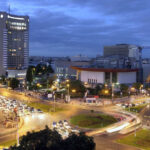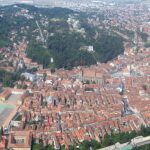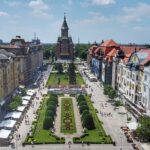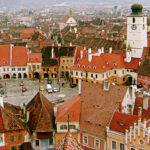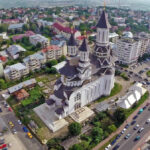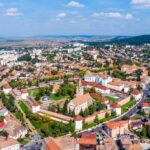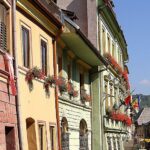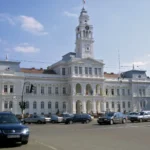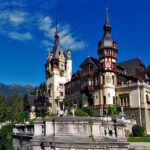Oradea
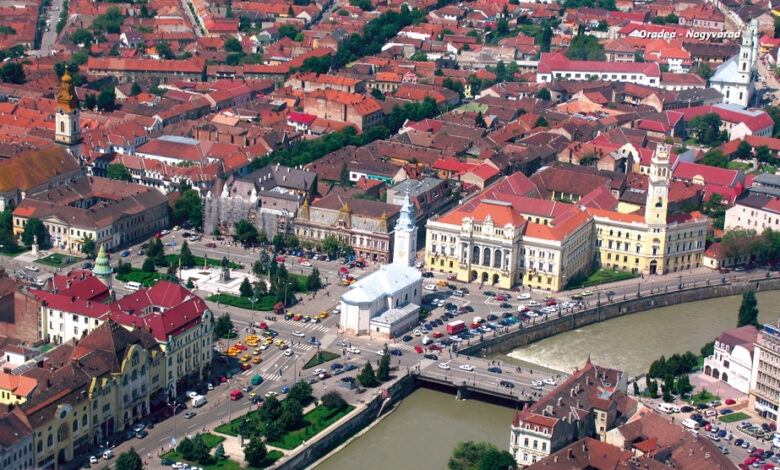
Situated near the Hungarian border, Oradea is often referred to as the “Art Nouveau city of Romania.” Its baroque buildings and diverse culinary scene reflect the city’s Austro-Hungarian influence. The Crișul Repede River adds to the city’s charm, providing a peaceful backdrop to its energetic atmosphere.
Discover the Black Eagle Palace and Oradea Fortress, and indulge in the delicious Romanian cuisine that can be found throughout the city. Oradea is a unique destination with a rich history that should not be overlooked.
| ID |
|---|
| 95445 |
| Name |
| Oradea |
| State ID |
| 4723 |
| State Code |
| BH |
| State Name |
| Bihor County |
| Country ID |
| 181 |
| Country Code |
| RO |
| Country Name |
| Romania |
| Latitude |
| 47.04580000 |
| Longitude |
| 21.91833000 |
| WikiData ID |
| Q16898113 |
Oradea (UK: , US: , Romanian: [oˈrade̯a]; Hungarian: Nagyvárad [ˈnɒɟvaːrɒd]; German: Großwardein [ˌɡʁoːsvaʁˈdaɪn]) is a city in Romania, located in the Crișana region. It serves as the administrative seat of Bihor County and an economic, social, and cultural hub in northwestern Romania. The city lies between rolling hills on the Crișana plain, on both banks of the Crișul Repede river.
The city lies about 10 km (6.2 mi) from the Hungarian border. Oradea is Romania's ninth most populous city (as of 2021). It covers 11,556 hectares (28,560 acres) between the Apuseni Mountains and the Crișana-Banat plain.
Oradea is known for its high standard of living and is frequently ranked among Romania's most liveable cities. It serves as the region’s major industrial and economic hub, hosting several of the country's largest industrial enterprises. The city is also renowned for its striking Art Nouveau architecture and is a member of both the Réseau Art Nouveau Network and the Art Nouveau European Route.
Etymology
The Romanian name Oradea originates from the city's Hungarian name Nagyvárad, colloquially shortened to Várad. Nagyvárad means "large castle" or "great citadel" in Hungarian. The Hungarian suffix -ad or -da is used for settlement names.
The city also has a German name, Großwardein, with a Yiddish version, גרױסװאַרדײן (Groysvardeyn). Other historical names include Turkish Varat or Varad, Latin Varadinum, and Italian Gran Varadino, as well as Romanian Oradia, Oradea Mare ("Great Oradea"), Varadia Mare ("Great Varadia") and Urbea Mare ("the Grand City").
Geography
The city lies at the junction of the Crișana plain and the Crișul Repede river basin. It sits 126 meters (413 feet) above sea level, bordered to the northeast by the Oradiei Hills, part of the Șes hills. The main part of the settlement lies on the floodplain and the terraces along the river Crișul Repede. Oradea is known for its thermal springs. The river Crișul Repede flows through the center of the city. Its flow depends on the season; the levees near Tileagd have partly controlled its floodwaters since the early 1980s.
Climate
Oradea has a humid continental climate (Köppen climate classification Dfb) with oceanic influences. Summers are long and hot, with cool nights. Winters are short and moderately cold. The city's local climate is influenced by the prevailing Western winds.
The annual average temperature is 10.4 °C (50.7 °F). In July, the average temperature is approximately 21 °C (70 °F), while in January, it averages −1.9 °C (28.6 °F). Rainfall is sufficient for the woods and vegetation of the zone, registering an annual average of about 78.1 cm (30.7 in). Rainfall is variably distributed throughout the year, with a maximum in June and a minimum in the late Autumn and Winter months.
History
While modern Oradea was first mentioned in 1113, under the Latin name "Varadinum", in a diploma belonging to Benedictine Zobor Abbey, the archaeological findings around the city provide evidence of virtually continuous habitation since the Neolithic age. This includes various Dacian and Celtic settlements. After the conquest of Dacia, the Romans built in the area, most notably in the Salca district of the city and Băile Felix. According to the Gesta Hungarorum, the region was ruled by Menumorut in the late 9th and early 10th centuries until the Hungarian conquest. Its citadel was centred at Biharea. Historians debate whether Menumorut was a historical ruler or merely legendary. According to Anonymus, Menumorut's duchy was populated primarily by Khazars and Székelys, and he acknowledged the suzerainty of the (unnamed) Byzantine Emperor of the time.
In the 11th century, King St. Ladislaus I of Hungary founded a bishopric settlement near the city of Oradea, the present Roman Catholic Diocese of Oradea.
The Regestrum Varadinense is a record of legal proceedings between 1208 and 1235, containing 711 place names and 2,500 personal names. The city flourished both economically and culturally during the 13th century as part of the Kingdom of Hungary. It was at this time that the Citadel of Oradea, first mentioned in 1241 during the Mongol invasion, was first built. The fortress would be destroyed and rebuilt several times over the following centuries. The 14th and 15th centuries were the most prosperous periods in the city's history up to that point. Many monuments were erected, including statues of Saints Stephen, Emeric, and Ladislaus (before 1372) and the equestrian sculpture of St. King Ladislaus I (1390). The famous statue of St. Ladislaus was the first proto-Renaissance public square equestrian monument in Europe. Bishop Andreas Báthori (1329–1345) rebuilt the Cathedral in Gothic style. From that epoch dates also the Hermes reliquary, now preserved at Győr, containing the skull of St. Ladislaus, a masterpiece of the Hungarian goldsmith's art.
It was at this time that astronomer Georg von Peuerbach wrote his Tabula Varadiensis, which was published posthumously in 1464. This publication marked the city's Observatory of Varadinum as the terrestrial point of reference and prime meridian.
In 1474, the city was besieged by the Turks during the absence of King Matthias Corvinus from the country. The city was severely damaged, but the king later resettled it with inhabitants from other parts of Hungary whom he exempted from taxes, a policy retained by Ferdinand I in 1553.
The Peace of Várad was concluded between Emperor Ferdinand I and John Zápolya here on 4 February 1538, in which they mutually recognized each other as legitimate monarchs. After the Ottoman invasion of Hungary in the 16th century, the city became a constant point of contention between the Principality of Transylvania, the Ottoman Empire, and the Habsburg monarchy. After the 1570 Treaty of Speyer, parts of Crișana, including Oradea, were incorporated into the newly formed Principality of Transylvania, a successor to the Eastern Hungarian Kingdom.
The Ottomans unsuccessfully laid siege to the city in 1598. After the Treaty of Vienna (1606), the city became a permanent part of the Principality of Transylvania by imperial decree.
After the Transylvanian Prince György Rákoczi II's failed attempt to gain the throne of Poland, the Ottomans again sent an expedition against him and his Wallachian and Moldavian allies: Gheorghe Ștefan and Constantin Șerban. In 1660, an Ottoman force of 45,000 men besieged the city for the last time. The 850 defenders managed to hold out for 46 days, but eventually, the city fell on 27 August 1660 due to internal treachery. The siege is described in detail by János Szalárdi, in a contemporaneous chronicle. The Ottomans designated the city as the capital of the newly formed Eyalet of Varat. The eyalet included the sanjaks of Varat (Oradea), Salanta, Debreçin, Halmaş, Sengevi, and Yapışmaz. The Ottoman rule of the city ended in 1692 when Habsburg imperial forces conquered it after a 14-month siege.
The city had been severely damaged in the war, with only 114 houses standing and 21 undamaged. Under the Habsburgs' reconstruction, in the 18th century, Oradea entered its golden age. The Viennese engineer Franz Anton Hillebrandt was given the task of planning the city in the Baroque style. Starting in 1752, many of the city's current landmarks were constructed, such as the Roman Catholic Cathedral, the Moon Church, the State Theatre, and the Baroque Palace.
The city played a major role in the Hungarian Revolution of 1848, being the home of the largest Hungarian arms factory.
After World War I, Oradea passed under Romanian control during the Hungarian–Romanian War of 1919 and became a part of the Kingdom of Romania under the Treaty of Trianon of 1920. In 1925, the city was designated a municipality, dissolving its former civic autonomy. Under the same ordinance, its name was changed from Oradea Mare (Great Oradea) to simply Oradea.
The Second Vienna Award, brokered by Hitler and Mussolini in 1940, allowed Hungary to recover Northern Transylvania, including Oradea, and mass celebrations welcomed the Hungarian administration. On 12 October 1944, Oradea was captured by Soviet troops of the 2nd Ukrainian Front during the Battle of Debrecen and reverted to Romanian administration in March 1945. After World War II, Hungary relinquished its claims to the city in accordance with the terms of the Treaty of Paris concluded on 10 February 1947.
After the Romanian Revolution of December 1989, many of the city's inhabitants looked forward to a more prosperous future as part of Romania's reforms toward democracy and a free market economy. Due to its history and institutions, Oradea is one of the most important economic and cultural centers of Romania, and is one of the country's main academic centers, with a unique Romanian-Hungarian bilingual dynamic.
Demographics
At the 2021 census Oradea had a population of 183,105, a decrease from the figures recorded during previous censuses.
Jewish community
- This section incorporates text from the 1901–1906 Jewish Encyclopedia, a publication now in the public domain.
The chevra kadisha ("holy society") was founded in 1735, the first synagogue in 1803, and the first communal school in 1839. Not until the beginning of the 19th century were Jews permitted to do business in any other part of the city, and even then, they were required to return at nightfall to their own quarter. In 1835, permission was granted to live in any part of the city.
The Jewish community of Oradea became divided into Orthodox and Neolog congregations. While the members of the Neolog congregation still retained their membership in the chevra kadisha, they started to use a cemetery of their own in 1899. In the early 20th century, the Jews of Oradea had won prominence in the public life of the city. There were Jewish manufacturers, merchants, lawyers, physicians, and farmers; in 1902, the chief of police was a Jew; and in the municipal council, the Jewish element was proportionately represented. The community possessed, in addition to the hospital and chevra kadisha, a Jewish women's association, a grammar school, a trade school for boys and girls, a yeshiva, a soup kitchen, etc.
According to the Center for Jewish Art:
The Oradea Jewish community was once the most active both commercially and culturally in the Austro-Hungarian Empire. In 1944, twenty-five thousand Oradean Jews were deported to concentration camps by the Nazis, thus decimating this vital community. Only three hundred Jews reside in Oradea today. In the center of the city, on the riverbank and towering over other buildings in the area, is the large Neolog Temple Synagogue, built in 1878. The unusual cube-shaped synagogue with its large cupola is one of the largest in Romania. Inside, there is a large organ and stucco decorations. In 1891, the Orthodox community also built a complex of buildings, including two synagogues and a community center.
In 1944, during the occupation of Hungary by Nazi Germany, Hungarian authorities forced the Jewish inhabitants into the Oradea ghetto before sending them to the Auschwitz concentration camp. Descendants of the pre-Holocaust Hasidic rabbinate in Oradea established a synagogue in the Willowbrook area of Staten Island, New York City. The synagogue maintains both a traditional Hasidic Nusach Sefard and a Nusach Ashkenaz service, the latter of which operates under the name Bais Medrash Igud Avreichim of Groisverdain (the Yiddish pronunciation of Grosswardein).
As of 2021, there is also a project to build a rabbinical seminary in Oradea.
Politics and administration
The city government is headed by a mayor. Since 2020, the office has been held by Florin Birta. Decisions are approved and discussed by the local government (consiliu local) made up of 27 elected councilors.
Quarters
Before 1848, Oradea was made up of four separate towns: Várad-Újváros (Villa Nova, former Vicus Szombathely), Várad-Olaszi (Villa Latinorum Varadiensium, "olasz" meaning Italian), Várad-Velence (Vicus Venetia), and Várad-Váralja (Civitas Waradiensis). The names Vicus Venetia, Villa Latinorum, Vicus Bolognia, Vicus Padua, and others refer to the French, Walloons, and Italian inhabitants who settled in the 13th century.
Today, the city is made up of the following districts, called quarters (cartiere in Romanian, negyedek in Hungarian):
Economy
Oradea has long been one of the more prosperous cities in Romania. The per capita GDP of Oradea is approximately 150% of the Romanian average. After 1989, due to its base of consumers, Oradea experienced an economic renewal, mostly in the services sector, such as trade and tourism.
Oradea has an unemployment rate of 6.0%, slightly lower than the Romanian average but significantly higher than Bihor County's average of approximately 2%. Oradea produces around 63% of the industrial production of Bihor County while accounting for 34.5% of the county's population. Its main industries are furniture, textiles, clothing, footwear, and food processing. Oradea's economy is sustained largely by small and medium businesses and the property taxes paid by citizens.
In the fiscal year 2012, Oradea had the largest budget in the Transylvania region, overcoming its neighbuor cities, Arad and Cluj-Napoca. Some large Romanian companies, such as Adeplast, RCS-RDS, European Drinks, and FrigoExpress are located in Oradea.
Oradea is using geothermal electricity from water two kilometers below ground, which provides 7% of the energy for its district heating system. That system serves 70% of the city's population with heat and hot water.
Transport
The public transport network in Oradea is operated by OTL (Oradea Transport Local), a municipal agency. It includes eight tram lines (1R, 1N, 2, 3R, 3N, 4R, 4N, and the newly introduced line 8), 17 local bus routes (numbered from 10 to 26), and one international suburban bus line to Biharkeresztes, Hungary. The metropolitan area is also served by regional buses connecting Oradea to nearby localities such as Băile Felix, Băile 1 Mai, Borș, and Sânmartin.
The city has four train stations: Oradea Central Station (commonly known as “Oradea”), West Station (located in the Ioșia district), East Station (in the Velența neighborhood), and Episcopia Bihor Station, near the Hungarian border, which serves international rail traffic.
Oradea International Airport reopened in late 2015 following runway renovations. It offers both domestic and international flights. The airport is connected to the city center via OTL bus line 28, as well as taxi and ride-hailing services.
Additional modes of transport in Oradea include:
- Taxi and ride-hailing services: Uber and Bolt operate in the city, offering ride options for various budgets and comfort levels. These services are also available for airport transfers.
- Bike and e-scooter sharing: Bolt and Uber occasionally offer shared bicycles and electric scooters. The city has more than 30 kilometers of dedicated bike lanes, including a cross-border cycling route to Hungary.
- Car sharing and vehicle rental: Bolt Drive allows users to rent cars by the hour or by the day directly from the app. Traditional car rental services are also available through local providers such as FlexiRent.
Education
The city is home to the University of Oradea, one of the largest universities in Romania. There are also several private universities, one being Agora University, founded in 2000. Emanuel University, an accredited private Baptist university, has also existed in the city since 1998. The Partium Christian University was established in 1995 and teaches in Hungarian.
As of 2012, there had been 232 years since the inauguration of higher education in Oradea and 48 years of continuous higher education. A higher institution for philosophic teaching was founded in Oradea in 1780, which became the Faculty of Law in 1788, the oldest faculty within a region of Eastern Europe.
After 1921, all courses at the Faculty of Law were taught in Romanian. In 1923, two theological academies were founded in Oradea. The Law Academy of Oradea, together with the two theological academies, was to make another step forward by integrating a faculty of letters, thus achieving the old desire of creating a University of Crișana in Oradea.
After a thirty-year break in the activity of the Law Academy of Oradea, on 1 October 1963, an order of the Ministry of Education established a 3-year Pedagogic Institute meant to address the scarcity of teachers in secondary education. The new institution of higher education began its activity with two faculties: Philology and Mathematics-Physics, and a year later, two other faculties, History-Geography and Physical Education, were added.
In May 1990, a decree of the Romanian Government established the Technical University of Oradea, later called the University of Oradea. This was an act of scientific and cultural restoration, and an achievement in Crișana after the Great Union on 1 December 1918. A historian of Oradea explains: "As regarding the future, the desire of all well-meant Romanians is to establish in Oradea a complete university, the lights of which will shine across the entire western border of Romania." The University of Oradea is an integrated institution of higher education, comprising 18 faculties.
The structure of the university contains academic education, postgraduate education, and scientific research.
Research within the University of Oradea is developing in natural and physical sciences, as well as in the area of social and human sciences, covering Mathematics, Physics, Chemistry, Life Sciences, Agricultural Sciences, Medical Sciences, Technological Sciences, Economical Sciences, Geography, History, Juridical Sciences and Law, Linguistics, Pedagogy, Political Sciences, Psychology, Letters and Arts, Sociology, and Philosophy.
The Sulyok István Reform College was founded in the spring of 1990 by the Királyhágómelléki Reform Church. In 1999, the school became entirely independent from the Protestant Theology College of Cluj-Napoca and changed its name to Partium Christian University. It presently operates with 12 faculties and a student body of 1400 and is taught in Hungarian.
Architecture
Oradea's architecture reflects a blend of historical influences, shaped by its political and cultural transitions over time. The city features a combination of Communist-era apartment blocks, predominantly in its peripheral neighborhoods, and a significant stock of historical buildings from the period when it was part of the Austro-Hungarian Empire. In addition to many Baroque buildings, Oradea has a collection of Art Nouveau architecture.
Located on Romania's western border, Nagyvárad (renamed Oradea after the Treaty of Trianon) was part of the Hungarian Kingdom until 1921, which was also part of the Central European Austro-Hungarian Empire, thereby being influenced by the artistic currents of Central Europe.
Many buildings constructed in Oradea during the early 20th century reflect influences from Ödön Lechner and the Vienna Secession movement. Architectural works from this period include a range of building types: rental palaces such as Moskovits Palace I and II, Apollo Palace, Stern Palace, Adorján Houses I and II, and Darvasy Palace; private villas including La Roche, Vágó, and Okany Schwartz; hotels such as Pannonia, Emke, Rimonoczy, Weiszlovics, and Fekete Sas (also known as Vulturul Negru); as well as military buildings along Armatei Române Street.
The city also developed industrial buildings and warehouses—such as beer, spirit, and brick factories, and the former electric plant chimney—alongside public institutions including the City Hall, the Palace of the Orthodox Bishopric, the Palace of the Greek-Catholic Bishopric, the Palace of Justice, and various bank and commercial buildings.
These structures were designed by a number of architects active in the Central European architectural scene of the early 1900s, including Ödön Lechner, Dezső Jakab, Marcell Komor, József and László Vágó, Valér Mende, Ferenc Sztarill, Ferenc Löbl, Kálmán Rimanóczy Sr. and Jr., and Anton Szallerbek.
Like many Central European cities, Oradea features architectural styles from the late 19th and early 20th centuries, including Secession (Art Nouveau), Eclectic, Romanian Revival, Neoclassical, and Baroque influences. The city has occasionally been referred to as "Small Paris" in reference to this architectural heritage. While the buildings are modest in scale, they are noted for their distinctive detailing and historical character. The architectural character of Oradea’s city center reflects a broad historical range, with buildings dating from the 16th century to the early 20th century. This area includes preserved urban layouts, historic structures, and monuments that illustrate the city’s development over several centuries. While the early 20th century is particularly well represented in the central district, architectural heritage can be found throughout various neighborhoods of the city.
The historic district contains numerous examples of Baroque, Neoclassical, Eclectic, and Romanian Revival styles, contributing to its architectural variety. Republicii Street is notable for its concentration of Secession (Art Nouveau) palaces, which exemplify the influence of Central European design trends. The city center has been recognised for its cultural, architectural, and urban planning significance within both national and regional heritage frameworks.
Tourist attractions
The old city centre is one of the main tourist highlights in Oradea, as are the Băile Felix health spas, accessible by bus and located just outside the city.
Other sites that attract tourists include:
- Baroque Palace of Oradea – today Muzeul Țării Crișurilor. It was the Roman Catholic bishop's palace until 1945, when the Communist regime took the building into public ownership. It was returned to the Roman Catholic Church in 2003. Its collection includes many fossils of dinosaurs and birds from the bauxite mines at Cornet-Brusturi.
- Roman Catholic Basilica-Cathedral of the Assumption of Mary, or simply "Baroque Cathedral" ("Catedrala barocă") – the largest Baroque cathedral in Romania, and home to a skull relic and 2 statutes of St. King Ladislaus I of Hungary.
- Cetatea Oradea – Oradea's Fortress, with a pentagonal shape, is a fortification with walls of rock on some portions and wood towers situated at the gate and at the corners.
- Biserica cu Lună – a church with an astronomical clock depicting the phases of the moon, a unique feature in Europe.
- Pasajul Vulturul Negru – the "Black Eagle Palace" (or "Eagle Palace") shopping galleria, named after its famous stained glass eagle in the ceiling.
- Ady Endre Museum – a museum dedicated to one of the greatest Hungarian poets and a former resident of Oradea.
- Teatrul de Stat Oradea – the Oradea State Theatre (also known as the Queen Mary Theatre, or Teatrul Regina Maria) on Ferdinand Square in the heart of the city, completed in 1900.
- Strada Republicii – regarded as one of the most beautiful streets of Transylvania, it displays a great number of Art Nouveau buildings.
- Some 100 religious sites of different denominations in Oradea, including three synagogues (only one still in use) and the largest Baptist church in Eastern Europe, Emmanuel Baptist Church.
Sports
CSM Oradea is Oradea's professional basketball club that plays in the country's 1st division, Liga Națională, a competition that the club won in 2016 and 2018, also competing in international competitions such as Champions League. The team plays its home matches at the Arena Antonio Alexe.
FC Bihor, founded in 1958, with club colors red and blue, featured a logo displaying the year 1902, marking the first football match played in Oradea in Réday Park. It was the city's most prominent football club for 58 years until it was dissolved in 2016, due to significant financial difficulties. A phoenix club appeared in 2022, under the same name FC Bihor Oradea
CA Oradea (CAO), founded in 1910, became famous after the annexation of Northern Transylvania by Hungary during WWII. The football club played in the Hungarian Championship under the Hungarian translation Nagyváradi Atlétikai Club (NAC), and won the championship at the end of the 1943–1944 season. CA Oradea is one of only three football clubs who played and won national championships in three countries (the other two are SK Rapid Wien and Derry City). After FC Bihor's dissolution, CAO was refounded in the spring of 2017, at 54 years after its dissolution. In the late years another club appeared on the city's football stage, Luceafărul Oradea, club that was founded in 2001 and now is playing in the Liga II, being the most representative football club of the city and Bihor County, at this moment.
Many important footballers were born in Oradea over time, such as: Iuliu Baratky, Cosmin Bărcăuan, Elemér Berkessy, Zeno Bundea, Zoltan Crișan, Claudiu Keșerü, Attila Kun, Erik Lincar, Marius Popa, Paul Popovici, Francisc Spielmann, Albert Ströck, and Ion Zare.
CSM Digi Oradea is Oradea's professional water polo club, it evolves in the Romanian Superliga, competition that it won 9 times in a row and also have a regular presence in LEN Champions League or LEN Euro Cup, being a finalist in the last one.
Twin Cities
Oradea is twinned with:
Metropolitan area
Oradea metropolitan area is a metropolitan area located in Western Romania, in the County of Bihor, Crişana Romania and was founded on 9 May 2005.
The metropolitan area comprises the city of Oradea and 8 adjacent communes:
- Biharia
- Borş
- Cetariu
- Nojorid
- Oşorhei
- Paleu
- Sânmartin
- Sântandrei.
Gallery
Notable people
Those born in Oradea
- Péter Pázmány (1570–1637), philosopher, theologian, cardinal.
- Sigismund Báthory (1572–1613), prince of Transylvania.
- Gabriel Báthory (1589–1613), prince of Transylvania
- Francis Rhédey (1610–1667), prince of Transylvania
- Ödön Beöthy (1796–1854), Hungarian deputy and orator.
- Emanoil Gojdu (1802–1870), lawyer
- József Nagysándor (1803–1849), honvéd general in the Hungarian Army
- Ede Szigligeti (1814–1878), playwright.
- Antal Csengery, (1822–1880), publicist and historical writer.
- Kálmán Tisza (1830–1902) the Hungarian prime minister between 1875 and 1890.
- Lucreția Suciu-Rudow (1859–1900), poetess
- Lajos Bíró (1880–1948), novelist, playwright and screenwriter
- Lajos Jambor (1884–1954), painter, muralist, illustrator
- Ernő Tibor (1885–1945), Impressionist and Neo-Impressionist painter
- Ernő Grünbaum (1908–1945), Expressionist painter
- Iuliu Baratky (1910–1962), footballer
- Francisc Spielmann (1916–1974), footballer
- Nándor Wagner (1922–1997), sculptor
- János Kristófi (1925–2014), painter
- Ovidiu Cotruș (1926–1977), essayist and literary critic
- Mircea Malița (1927–2018), academic, diplomat, and politician
- Mircea Zaciu (1928–2000), critic and literary historian
- Titus Popovici (1930–1994), screenwriter
- Eva Heyman (1931–1944), Jewish girl, often compared to Anne Frank because of the diary she kept
- Iosif Demian (b. 1941), cinematographer and film director
- A. G. Weinberger (b. 1965), musician and radio producer
- Gavril Farkas (b. 1973), mathematician
- Cosmin Bărcăuan (b. 1978), football player
- Erik Lincar (b. 1978), football player and manager
- Alin Suciu (b. 1978), coptologist and papyrologist
- Kálmán Kádár (b. 1979), water polo player
- Mihai Neșu (b. 1983), football player
- Gabriella Szűcs (b. 1984), handball player
- Claudiu Keșerü (b. 1986), football player
Those who lived in Oradea
- Roger of Torre Maggiore (1205–1266), Italian monk
- John Vitéz (1408–1472), bishop and humanist, he established in Oradea the first observatory from Southeast Europe
- George Martinuzzi (1482–1551), Bishop of Nagyvárad.
- Michael Haydn (1737–1806), Austrian composer
- Ignațiu Darabant (1738–1805), Eparchy of Oradea Mare bishop
- Carl Ditters von Dittersdorf (1739–1799), Austrian composer and violinist.
- Wenzel Pichl (1741–1805), Czech composer
- Samuil Vulcan (1758–1839), Eparchy of Oradea Mare bishop
- Mihail Pavel (1827–1902), Eparchy of Oradea Mare bishop
- Iosif Vulcan (1841–1907), magazine editor, poet, playwright, novelist
- Roman Ciorogariu (1852–1936), Romanian Orthodox bishop
- Demetriu Radu (1861–1920), Eparchy of Oradea Mare bishop
- Valeriu Traian Frențiu (1875–1952), Eparchy of Oradea Mare bishop
- Endre Ady (1877–1919), Hungarian poet
- Alex Leon (1907-1944), painter
- Iuliu Bodola (1912–1992), football player
- Emerich Jenei (n. 1937), former football player and coach
- Alexandru Darie (1959–2019), theater director
- Antonio Alexe (1969–2005), basketball player
Royalty buried in Oradea
- Ladislaus I of Hungary (1040-1095).
- Stephen II of Hungary (1101-1131)
- Andrew II of Hungary (1175-1235).
- Fenenna of Kuyavia (1276-1295)
- Beatrice of Luxembourg (1305-1319)
- Mary, Queen of Hungary (1371-1395)
- Sigismund, Holy Roman Emperor (1368-1437).
See also
- Diocese of Oradea (disambiguation)
- History of Oradea
- Timeline of Oradea
Sources
This article incorporates text from a publication now in the public domain: Herbermann, Charles, ed. (1913). "Diocese of Grosswardein". Catholic Encyclopedia. New York: Robert Appleton Company.
References
External links
- Oradea travel guide from Wikivoyage
- Oradea Town Hall (in Romanian)
- Oradea, Romania at JewishGen
- "Nagy-Várad" . Encyclopædia Britannica. Vol. 19 (11th ed.). 1911. pp. 152–153.
References
- http://www.oradea.ro/
- http://www.zmo.ro/movie.html
- http://www.emanuel.ro/
- http://www.meteoromania.ro/index.php?id=475
- http://www.edrc.ro/recensamant.jsp?regiune_id=2140&judet_id=2141&localitate_id=2142
- http://varga.adatbank.transindex.ro/?pg=3&action=etnik&id=1233
- http://www.bihor.insse.ro/phpfiles/Comunicat%20-%20DATE%20PROVIZORII%20RPL%202011.pdf
- http://www.romanialibera.ro/actualitate/locale/topul-bugetelor-locale-din-transilvania-si-banat-253725.html
- http://www.hhrf.org/erdelyinaplo/cikk_nyomtatas.php?id_cikk=10427
- http://www.welcometoromania.ro/Oradea/Oradea_Bazilica_Rom_Cat_r.htm
